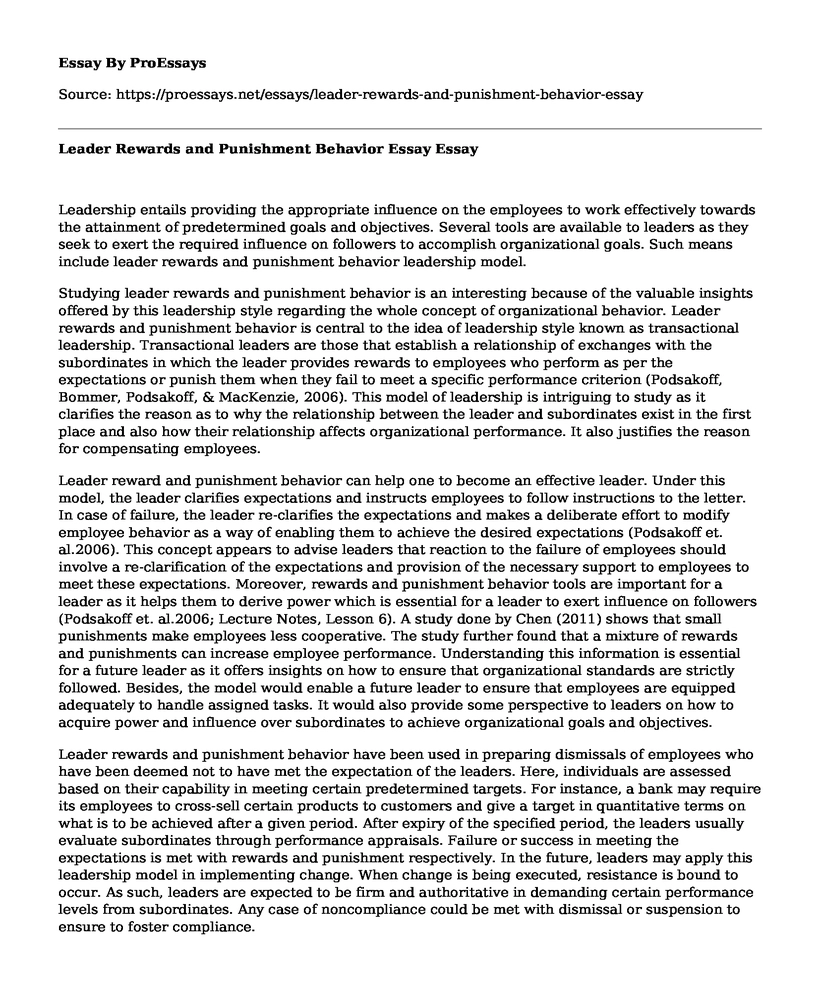Leadership entails providing the appropriate influence on the employees to work effectively towards the attainment of predetermined goals and objectives. Several tools are available to leaders as they seek to exert the required influence on followers to accomplish organizational goals. Such means include leader rewards and punishment behavior leadership model.
Studying leader rewards and punishment behavior is an interesting because of the valuable insights offered by this leadership style regarding the whole concept of organizational behavior. Leader rewards and punishment behavior is central to the idea of leadership style known as transactional leadership. Transactional leaders are those that establish a relationship of exchanges with the subordinates in which the leader provides rewards to employees who perform as per the expectations or punish them when they fail to meet a specific performance criterion (Podsakoff, Bommer, Podsakoff, & MacKenzie, 2006). This model of leadership is intriguing to study as it clarifies the reason as to why the relationship between the leader and subordinates exist in the first place and also how their relationship affects organizational performance. It also justifies the reason for compensating employees.
Leader reward and punishment behavior can help one to become an effective leader. Under this model, the leader clarifies expectations and instructs employees to follow instructions to the letter. In case of failure, the leader re-clarifies the expectations and makes a deliberate effort to modify employee behavior as a way of enabling them to achieve the desired expectations (Podsakoff et. al.2006). This concept appears to advise leaders that reaction to the failure of employees should involve a re-clarification of the expectations and provision of the necessary support to employees to meet these expectations. Moreover, rewards and punishment behavior tools are important for a leader as it helps them to derive power which is essential for a leader to exert influence on followers (Podsakoff et. al.2006; Lecture Notes, Lesson 6). A study done by Chen (2011) shows that small punishments make employees less cooperative. The study further found that a mixture of rewards and punishments can increase employee performance. Understanding this information is essential for a future leader as it offers insights on how to ensure that organizational standards are strictly followed. Besides, the model would enable a future leader to ensure that employees are equipped adequately to handle assigned tasks. It would also provide some perspective to leaders on how to acquire power and influence over subordinates to achieve organizational goals and objectives.
Leader rewards and punishment behavior have been used in preparing dismissals of employees who have been deemed not to have met the expectation of the leaders. Here, individuals are assessed based on their capability in meeting certain predetermined targets. For instance, a bank may require its employees to cross-sell certain products to customers and give a target in quantitative terms on what is to be achieved after a given period. After expiry of the specified period, the leaders usually evaluate subordinates through performance appraisals. Failure or success in meeting the expectations is met with rewards and punishment respectively. In the future, leaders may apply this leadership model in implementing change. When change is being executed, resistance is bound to occur. As such, leaders are expected to be firm and authoritative in demanding certain performance levels from subordinates. Any case of noncompliance could be met with dismissal or suspension to ensure to foster compliance.
Conclusion
In summation, leader rewards and punishment behavior concept is an interesting topic of discussion as it offers useful tools of leading people. This model could be helpful for an aspiring leader as it challenges the leader to focus on employee needs. It could also be beneficial in ensuring that organizational standards are followed as expected, and performance targets are realized. Moreover, rewards and punishment behavior could be used to address resistance against change in the workplace. Overall, rewards and punishment behavior are effective in helping organizations achieve their goals and objectives if a proper mix with other variables in factored.
References
Chen, M. (2012). The effect of leader reward and punishment behaviors on subordinates' budget reports. The Engineering Economist, 57(1), 41-54. doi:10.1080/0013791x.2011.650839
Podsakoff, P. M., Bommer, W. H., Podsakoff, N. P., & MacKenzie, S. B. (2006). Relationships between leader reward and punishment behavior and subordinate attitudes, perceptions, and behaviors: A meta-analytic review of existing and new research. Organizational Behavior and Human Decision Processes, 99(2), 113-142. doi:10.1016/j.obhdp.2005.09.002
Cite this page
Leader Rewards and Punishment Behavior Essay. (2022, Sep 07). Retrieved from https://proessays.net/essays/leader-rewards-and-punishment-behavior-essay
If you are the original author of this essay and no longer wish to have it published on the ProEssays website, please click below to request its removal:
- Production and Cost Analysis
- Paper Example on Importance of Learning How to Be a Follower
- Cyber-Physical Production System in Manufacturing Paper Example
- Essay Sample on Atradius Organizational and Management Philosophy Adaptation
- Managing People and Organizations Essay Example
- Essay Example on Survival in a Changing World: The Power of an Effective Strategic Plan
- Essay Sample on Achieving Global Leadership: Quality Management and Programs







